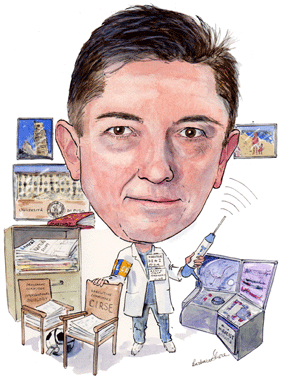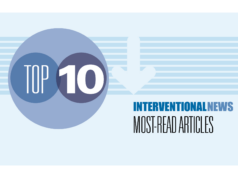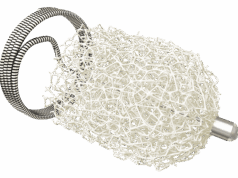
As a former football referee, Riccardo Lencioni tells Interventional News readers how important it is to respect the rules —how important it is to design and carry out trials that meet accepted standards, so that other specialties involved in cancer care can see the worth of what interventional oncology can offer. He tells the story of how this field was born: how enthusiasts with ideas frequented Gino’s pizzeria in Chicago, brimming with excitement, even though there was no money even to book a conference room! Lencioni is director, Division of Diagnostic Imaging and Intervention, Pisa University Hospital and School of Medicine, Pisa, Italy.
How did you come to choose medicine as a career?
Well, my father is a doctor, so I grew up with the idea of studying medicine. At four, I was already playing the “amateur surgeon” game all day, trying to deal with diseased organs by using a bizarre armamentarium of strange tools. Some might say things have not changed much since then!
Who are the people who have influenced you most? What advice of theirs do you follow even today?
Of course, my mind first recalls my mentor, Professor Carlo Bartolozzi. The year he moved to Pisa to take the chair of radiology, I was ranked number one in the admission test for radiology residency. I began learning in a very lively clinical, scientific and academic environment, under the common denominators of a rigorous methodology and a full-time dedication to work. His advice I follow even today: practice, practice, practice! I also had the privilege of meeting many pioneers and international thought leaders in interventional radiology early in my professional life. Professor Andy Adam is probably the one who has influenced me most and who drew me to fully embrace interventional radiology. Andy has the unique ability to set you thinking: in soccer terms, he makes the perfect “assist”—the kind of pass that enables you to score a goal. You think it is your goal, but in fact it is his.
Which interventional radiology innovations have shaped your career?
I was lucky enough to be right in the middle of the action when most interventional procedures for cancer treatment were developed. Transarterial chemoembolization (TACE) and ablation were introduced in liver cancer treatment in the early 90s, while I was doing my radiology residency. I was thrilled by the idea of using image-guided interventions to cure cancer and I dedicated myself full-time to this new field. The year I completed my radiology residency, 1994, I had already published in Cardiovascular and Interventional Radiology on the first western experience on the combination of TACE and ablation for hepatocellular carcinoma, followed one year later by the first report, in Cancer, analysing survival outcomes and prognostic factors. In a few years, interventional oncology became one of the most inspiring areas of development within interventional radiology, and I had the opportunity of investigating several new techniques and devices and to explore novel clinical applications.
As an internationally recognised expert in interventional oncology, what are three big questions in the field you would like to see the answers to?
First, will image-guided ablation ever be considered as a true replacement for surgical resection, i.e., will it ever become the first-line approach in cancer treatment? Second, will locoregional transcatheter therapies ever reach another dimension and become a firmly established regimen in oncology protocols beyond HCC? Third – and most important – will interventional radiologists be able to implement a structured educational programme in interventional oncology that will eventually create physicians who are full interventional radiologists but at the same time share the same basic background in cancer biology and treatment with medical oncologists, surgical oncologists, and radiation oncologists? I certainly predict a “yes” to all these questions!
Can you describe a memorable case, and how interventional oncology came to the rescue?
The first case that comes to my mind is a procedure that I actually denied to a patient. A young woman was referred to us with the diagnosis of multiple unequivocal hepatic metastases from an unknown primary cancer. She was in the fifth month of pregnancy, and was clearly distraught at such a diagnosis. The plan was to perform a biopsy in the operating room for her, obtain immediate confirmation of malignancy, and proceed with the abortion followed by chemotherapy. As soon as I was shown the case, I had a flashback to another case I had seen, maybe ten years before. I told the referring clinicians that the lesions were not metastases and that in my opinion the patient had an epithelioid hemangioendothelioma.
This is an extremely rare tumour, and the diagnosis is extremely difficult: even biopsy findings may be misleading and direct toward metastatic adenocarcinoma. I assumed all the responsibilities of the management of the patient and persuaded the young lady not to do anything and to keep going with the pregnancy. You would not believe how many phone calls I received from all my colleagues who were involved in the case! I think that if they had not known me, they would have thought that I was completely crazy. Well, the baby is now three, and his mother’s epithelioid hemangioendothelioma is under control.
Which developing techniques and technologies are you watching closely for the future?
Well, there are so many. In the field of image-guided ablation, I am intrigued by the several novel thermal and non-thermal techniques which have potential to overcome the limitations of radiofrequency ablation to reach a new dimension in local tumour treatment. On the other hand, I have no doubt that interventional techniques for transcatheter drug delivery will substantially expand their role in regional cancer treatment, perhaps in combination with systemically-active drugs. The next few years will see key developments as several pivotal clinical trials are currently on-going.
Can you share some of the proudest moments in your career?
I do not have an inflated ego. But of course it was great when I became a tenured professor of radiology before 40, something not so common in Italy. I was also thrilled when I was invited to deliver honorary lectures, such as the Hans Popper lecture at the Mount Sinai School of Medicine in New York and the Andreas Gruentzig lecture at the CIRSE annual meeting. Seeing my name written next to those who have made the history in the field was simply amazing.
What still fascinates you about interventional radiology?
Innovation. Interventional radiology is such a dynamic specialty. Almost every single day there is something new: a new device, a new approach, a new clinical application, or just a new idea. No two days are the same.
Could you name one moment in the history of interventional oncology that you look back at and think, “wow”?
I remember how it all started. The meetings organised in the early 90s during the RSNA by a small group of pioneers. We used to meet at Gino’s Pizza in Chicago: there were no sponsors at that time, we did not have the money to book a conference room! But the enthusiasm was unbelievable, we had the feeling that something was happening. And I still recall when— few years later—we agreed that the time was come to give a name to the growing number of vascular and non-vascular interventions increasingly used in cancer treatment. It was the birth of interventional oncology.
What are the three most interesting current trials in hepatocellular carcinoma that you are waiting to see the results of?
I think one of the most important areas for research in hepatocellular carcinoma is to explore the synergies between locoregional interventional treatments—ablation or chemoembolization—and systemically-administered drugs. If I have to mention three key trials that are currently on-going, I would refer to the ones assessing (1) the use of the molecular target agent with anti-angiogenic and antiproliferative properties, sorafenib, in combination with transarterial chemoembolization; (2) the clinical benefit of drug-eluting beads over conventional transarterial chemoembolization; and (3) the value of thermally-sensitive liposomal doxorubicin carriers in combination with radiofrequency ablation. Each of these trials will recruit hundreds of patients, and each also has a randomised study design. These are trials that have the potential to revolutionise the current therapeutic management of hepatocellular carcinoma.
What has your research contributed to the field of interventional oncology?
An area that I have extensively investigated is the use of image-guided ablation in cancer treatment: the seminal paper we produced in 1998 on radiofrequency ablation for colorectal metastases was awarded as the most cited publication of European radiology. We also completed the first randomised trial on radiofrequency ablation for hepatocellular carcinoma in 2003 and the first analysis on long-term survival of treated patients in 2005, both studies published in Radiology. I think the publication in The Lancet Oncology of the first multicentre trial on radiofrequency ablation of lung malignancies in 2008 was also an important step forward for interventional oncology, given that it appeared in a top oncology title. Another area in which I focused my research is the combination of transcatheter and percutaneous approaches in cancer treatment: we have produced several publications on this topic, including the first pilot clinical study on the combined use of radiofrequency ablation and drug-eluting beads for hepatocellular carcinoma treatment that appeared in the Journal of Hepatology recently. Currently, I am a co-principal investigator of a few clinical trials exploring the synergies between locoregional interventional treatments and systemically-active drugs.
What are most interesting new concepts to have emerged in interventional oncology?
I think we are at the point where we understand “yes we can”, but we need to persuade the oncology community that what we can do is worth doing. This means to run trials according to accepted research standards and to produce sound evidence of clinical benefit. I think we all acknowledge the importance of creating a common framework for research. As a former professional soccer referee, I fully acknowledge that the rules are important! That is why I was happy to be part of the panel that has crafted the guidelines for the design of clinical trials in hepatocellular carcinoma, an effort that also led to the development of new criteria for tumour response assessment—the mRECIST model—that seem to better reflect the anticancer activity of interventional procedures and molecular targeted therapies. Hopefully, similar efforts will be conducted in other cancers as well.
What are your interests outside of medicine?
I live on the coast in Tuscany, so I love the sea, sailing or just walking on the beach (but I do not own a boat!). I am now writing a book—not on medicine or interventional radiology. In reality, now, my main activity is to spend time with my daughter, Elisabetta, who is four years old.
Fact File
Key academic and professional appointments
1994 Board Certification in Radiology, University of Pisa, Italy
1995 Contract professor of Interventional Radiology, University of Pisa, Italy
2000 Tenured associate professor of Radiology, University of Pisa, Italy
2008 Director, Diagnostic Imaging and Intervention, University Hospital, Pisa, Italy
2010 European Board of Interventional Radiology
Recent activities in scientific societies
2005 Chairman, CIRSE Standard of Practice Committee
2006 Co-chair, 1st World Conference on Interventional Oncology
2007 Chairman, ECR Subcommittee “Abdominal and Gastrointestinal”
2008 Co-chair, 1st European Conference on Interventional Oncology
2008 Chairman, Oncology Division, CIRSE Foundation
2009 Chairman, CIRSE Membership Committee
2010 Co-chair, 2nd European Conference on Interventional Oncology
2011 Executive secretary, International Liver Cancer Association
2011 Co-chair, 6th World Conference on Interventional Oncology
2012 Co-chair, 3rd European Conference on Interventional Oncology
Publications
153 articles in peer-reviewed international journals
61 chapters in textbooks of radiology, IR, surgery, oncology, gastroenterology / hepatology
Seven books
Cumulative impact factor >500, more than 6,000 citations
Congresses
Invited lecturer at 450 international meetings or conferences held in 58 different countries











